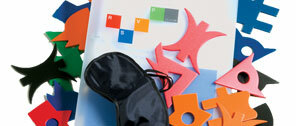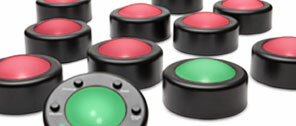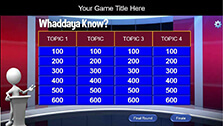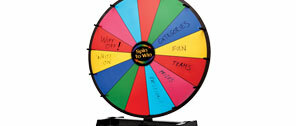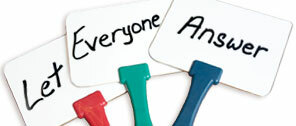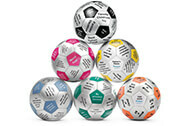PuzzleBlind® Team-Building Game is an immersive corporate training activity designed to strengthen communication, trust, and role clarity. In this exercise, blindfolded builders must assemble a puzzle while coaches provide verbal instructions. The challenge highlights teamwork, leadership, and the importance of clear communication—making it a favorite for leadership retreats, manager training, conflict resolution workshops, and corporate team-building events.
WHY FACILITATORS LOVE IT
- High-impact learning: Teams immediately see how poor communication creates misalignment and how clarity builds success.
- Versatile: Works as a leadership exercise, energizer, or corporate icebreaker.
- Memorable experience: Blindfolds and timed construction create an engaging challenge with lasting lessons.
- Practical debrief: Surfaces real workplace issues like unclear directions, assumptions, and role confusion.
- Role clarity: Teams shift between strategists (coaches) and executors (builders), exploring leadership styles and decision-making dynamics.
- Trust under pressure: Without sight, participants must trust instructions and each other—trust becomes both the method and the lesson.
- Adjustable difficulty: Add or remove rules (e.g., only coaches speak, all blindfolded, one question per turn) to scale challenge and insights.
LEARNING OUTCOMES
This game is a useful tool to discuss the following interteam-dynamics:
- Improve communication and listening skills
- Build trust and team alignment when solving problems
- Clarify roles and responsibilities, including choosing and developing leaders
- Practice conflict resolution and problem-solving
- Increase confidence in leading and coaching others
- Listening to multiple speakers and perspectives and addressing when teammates talk over each other
WHAT’S INCLUDED
- Puzzle pieces set -- Oversized puzzle have texture on one side
- Durable blindfolds for team members
- Facilitator guide with setup, instructions, and debrief prompts
- Reusable tote bag for easy storage and transport
BEST USES
- Corporate training and leadership development programs
- Team-building workshops and offsite retreats
- Conflict resolution or communication skills training
- Energizer or icebreaker at the start of a meeting
- Hybrid or remote team sessions (with creative adaptation)
- Leadership development by rotating roles and debriefing leadership behavior
FAQS
Q: What’s the ideal group size?
A: Flexible—typically 4–8 players per puzzle, but works well with parallel teams for larger groups.
Q: What skills do participants develop?
A: Teams practice communication, trust, listening, coaching, and conflict resolution—all under realistic workplace-like conditions.
Q: What materials are included?
A: Each kit comes with puzzle pieces, blindfolds, a facilitator guide, and a tote bag. All materials are durable, safe, and reusable.
Q: Who benefits most from this activity?
A: Trainers, HR teams, managers, and leaders running workshops on communication, collaboration, and team trust.
Q: How long does it take?
A: Plan for a 30+ minute activity—15 minutes to strategize and play, plus debrief time.
FACILITATING PUZZLEBLIND
Before you begin:
- Scatter the puzzle pieces on the ground with the textured side up (the other side is smooth).
- Assemble your team around the puzzle
- Let them know that some portion of their team will need to assemble the puzzle blindfolded.
- 1 RULE: Only blindfolded players can touch the puzzle pieces
- Give teams up to 10 minutes to strategize -- to choose a leader(s), decide how many players (and who) will be blindfolded, etc.
- NOTE: see below for additional facilitation choices that will increase the challenge.
Expect the game to take 30+ minutes depending on your group and the depth of your debrief.
PUZZLEBLIND AS A TEAM BUILDING GAME
When playing PuzzleBlind, facilitators can adjust the experience to focus on a range of communication and teambuilding challenges. Consider some of these options:
- One coach & many builders - See what happens when only one team member is sighted, and all the others are blindfolded. While the coach is directing one builder, what do the others do? How do they communicate with each other? Are they talking over each other? Do they wait for the leadership of the only one with vision?
- Two coaches & one builder - Explore how the two coaches interact. Are they both shouting instructions? Is one determining which pieces should fit together, and the other focused on communicating to the builder?
- Multiple coaches & multiple builders - Watch to see how they organize themselves and communicate with one another as you add more people to the challenge. Do they include everyone in the group or are just a few interacting?
Increase the difficulty by adding these rules:
- Only the coaches can speak; builders must be silent.
- All players are blindfolded... no sighted coaches.
- Each builder can ask only one question of the coach.
- Only one person can speak at a time.
PUZZLEBLIND PUZZLE PIECES
The game was designed to optimize the team building experience:
- Each of the 12 pieces are shaped so that each can be uniquely described.
- Every piece is recognizably different from every other piece.
- Foam material is extremely light weight so players can move pieces around easily.
- Giant size makes the activity suitable for groups of 2-6 adults.
- Multiple completed puzzles fit together, extending the application of the game to inter-group collaboration.
- Finished puzzle measures 4.5' x 6' / Individual pieces measure approximately 20" x 20"
- One side of the pieces has a texture, the other is smooth.
- 6 Blindfolds are included
SPACE & SET UP
Be sure you have ample space for the players and the puzzle. The completed puzzle measures approximately 6' x 4.5'.
Depending on the number of coaches and builders you choose, you might opt to keep all the puzzle pieces stacked in a pile or laid out on the ground.
ADDITIONAL FACILITATION NOTES ARE INCLUDED WITH THE GAME
COMPARISON CHART
Not sure which team-building activity is right for your group? Trainers Warehouse offers a variety of experiential learning games that build skills in communication, collaboration, adaptability, leadership, and conflict resolution. Use the chart below to compare five of our most popular activities—PuzzleBlind®, Helium Stick®, TeamWRITER®, Shape Up!®, and Team 10®—and choose the one that best fits your training goals, group size, and workshop format.
| Activity | Ideal Group Size | Core Skills Developed | Time Required | Key Dynamic | Best For |
|---|---|---|---|---|---|
| PuzzleBlind® | 4–8 players per puzzle (parallel teams for larger groups) | Communication, trust, listening, coaching, conflict resolution | ~30–40 minutes (play + debrief) | Builders are blindfolded, coaches give verbal instructions | Leadership training, conflict resolution, communication workshops |
| Helium Stick® | 8–12 participants per stick | Communication, alignment, group focus, patience | ~20–30 minutes (setup + play + debrief) | Teams must lower a lightweight rod without it rising up | Quick energizer, communication warm-up, leadership retreats |
| TeamWRITER® | 6–12 participants (expandable with multiple pens/strings) | Collaboration, interdependence, coordination, listening | ~20–30 minutes (assembly + play + debrief) | Teams collectively pull strings to guide a pen and write/draw | Collaboration workshops, leadership development, trust building |
| Shape Up!® | Small teams of 4–6 per set (multiple sets scale up) | Problem-solving, communication, collaboration, | ~20-30 minutes (multiple rounds + debrief) | Players must figure out which of their pieces is a duplicate | Problem-solving workshops, collaboration training, communication skill-building |
| Team 10® | Groups of 4–8 players | Adaptability, resilience, dealing with disruption, collaborative planning | ~20–30 minutes (play + debrief) | Teams search for 10 matching cards until a “Scramble” card forces to begin again | Change management workshops, adaptability training, and teamwork energizer |

